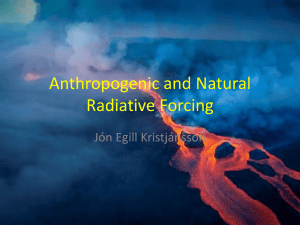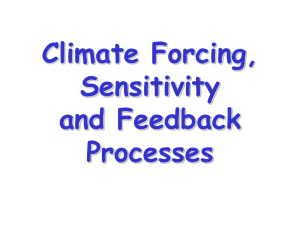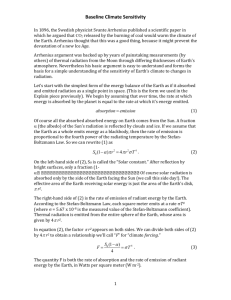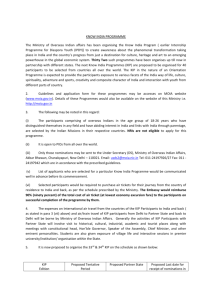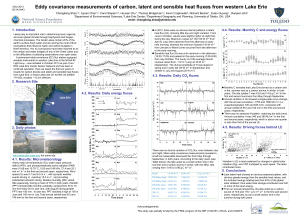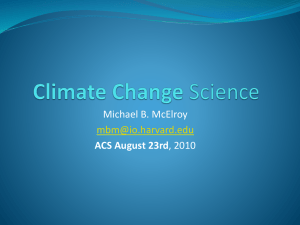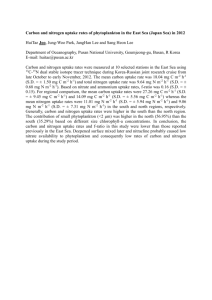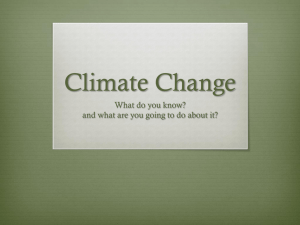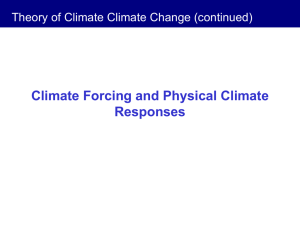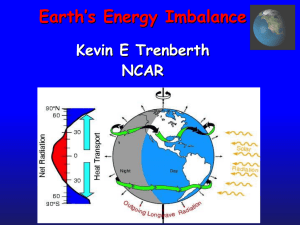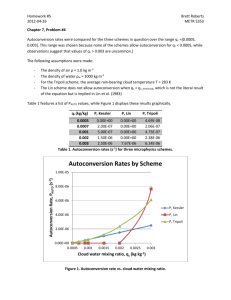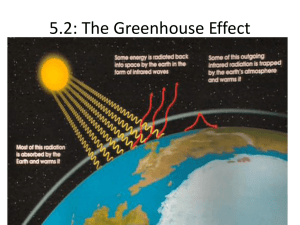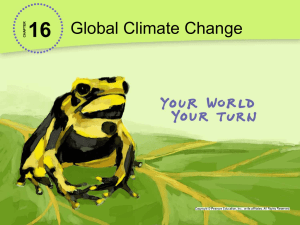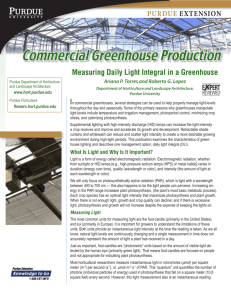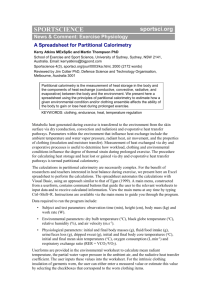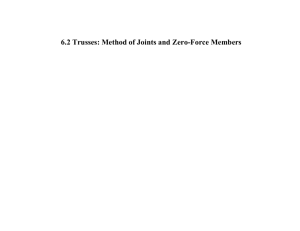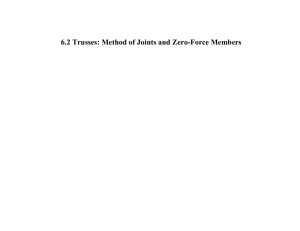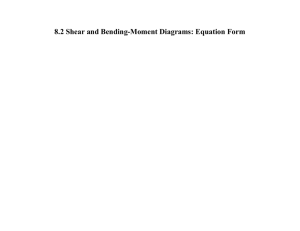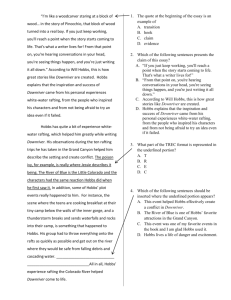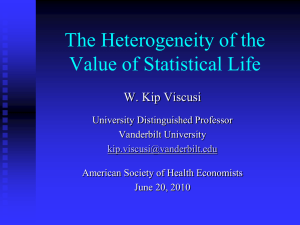Source: Nese and Grenci (2010) - Penn State Meteo Computing
advertisement
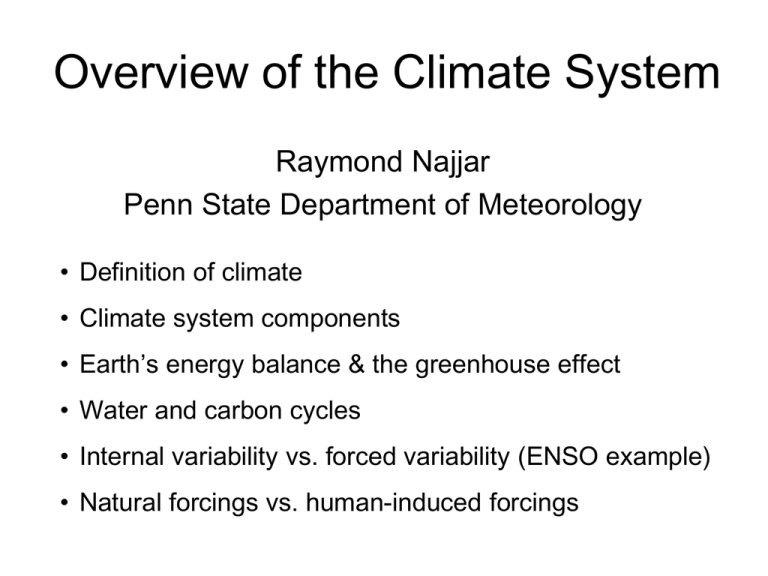
Overview of the Climate System Raymond Najjar Penn State Department of Meteorology • Definition of climate • Climate system components • Earth’s energy balance & the greenhouse effect • Water and carbon cycles • Internal variability vs. forced variability (ENSO example) • Natural forcings vs. human-induced forcings Climate of a region: Statistical description of that region’s weather Portlands Winter temperature probability distributions Portland, ME (43.7°N) Portland, OR (45.5°N) Source: NWS Climate Prediction Center Factors affecting a region’s climate • • • • • • Latitude Elevation Proximity to ocean Prevailing wind direction Atmospheric composition Land surface type Visible image Minneapolis Source: Nese and Grenci (2010) Infrared image Minneapolis Source: CLIVAR Program Source: Wallace and Hobbs (2006). Based on Earth Radiation Budget Experiment (ERBE), 1985-1986 Source: Wallace and Hobbs (2006). Based on Earth Radiation Budget Experiment (ERBE), 1985-1986 Source: Wallace and Hobbs (2006). Based on Earth Radiation Budget Experiment (ERBE), 1985-1986 Average = 30 W m-2 (warming) Shortwave forcing average = 50 W m-2 (cooling) Net effect: clouds cool 20 W m-2 Source: National Research Council (2008) Global energy balance Source: Kiehl & Trenberth (1997) IR radiative forcing of the climate IR radiation leaving the surface that is absorbed in atmosphere = 390 W m-2 – 235 W m-2 = 155 W m-2 Cloud IR forcing = 30 W m-2 Greenhouse gas forcing = 125 W m-2 Absorptivity of gases in the atmosphere 6% 8% 26% 60% solar radiation terrestrial radiation Sources: Nese & Grenci (2010), Kiehl & Trenberth (1997) Increasing due to human activity Dominant greenhouse gas Contribution to GHG forcing Calculation of surface temperature without greenhouse forcing Energy in = Energy out Incoming solar = reflected solar + outgoing IR 1366 W m-2 = (0.30)(1366 W m-2) + 4sT4 T = 254 K = -19° C = 2° F Greenhouse effect warms surface ~60° F The global water cycle Source: Trenberth et al. (2007) The global carbon cycle Black = preindustrial, Red = 1990s change Denman et al. (2007) CO2 role in greenhouse effect • ~ 25% of clear-sky greenhouse effect • ~ 20% of total greenhouse effect • ~ 0.06% of the mass of the atmosphere Forced vs. internal variability of climate • Forced: due to “external” processes; e.g. solar, volcanic, & humans • Internal: unforced variability; e.g. ENSO, NAO, PDO, AMO, etc. Current conditions in the Tropical Pacific Source: www.pmel.noaa.gov/tao Temperature section in the Equatorial Pacific Source: www.pmel.noaa.gov/tao Source: www.pmel.noaa.gov/tao Source: Nese and Grenci (2010) ENSO variability over the past 60 years MEI computed from surface winds, surface air and water temperature, and cloud fraction Source: www.esrl.noaa.gov/psd/enso/mei/ Natural vs. Human-induced forcing of climate • Natural: solar, earth-orbital, volcanic • Human-induced: land use change, greenhouse gases, aerosols, soot Discussion References Denman, K.L., Brasseur, G., Chidthaisong, A., Ciais, P., Cox, P.M., Dickinson, R.E., Hauglustaine, D., Heinze, C., Holland, E., Jacob, D., Lohmann, U., Ramachandran, S., da Silva Dia, P.L., Wofsy, S.C., Zhang, X., 2007. Couplings between changes in the climate system and biogeochemistry. In: S. Solomon, D. Qin, M. Manning, Z. Chen, M. Marquis, K.B. Averyt, T. Tignor, H.L. Miller (Editors), Climate Change 2007: The Physical Science Basis. Contribution of Working Group I to the Fourth Assessment Report of the Intergovernmental Panel on Climate Change. Cambridge University Press, Cambridge University Press, Cambridge, United Kingdom and New York, NY, USA. Kiehl, J.T., Trenberth, K.E., 1997. Earth's annual global mean energy budget. Bulletin of the American Meteorological Society 78, 197-208. National Research Council Committee on Scientific Accomplishments of Earth Observations from Space, 2008. Earth Observations from Space: The First 50 Years of Scientific Achievements. The National Academies Press, Washington, D. C., 142 pp. Nese, J.M., Grenci, L.M., 2010. A World of Weather: Fundamentals of Meteorology, Fifth Edition. Kendall Hunt Publishing Company, Dubuque, Iowa, 794 pp. Trenberth, K.E., Smith, L., Qian, T., Dai, A., Fasullo, J., 2007. Estimates of the Global Water Budget and Its Annual Cycle Using Observational and Model Data. Journal of Hydrometeorology 8, 758-769. Wallace, J.M., Hobbs, P.V., 2006. Atmospheric Science: An Introductory Survey, Second Edition. Elsevier, Inc., Oxford, UK, 483 pp. Extra slides CO2 emissions from human activity (black) compared with the rate of increase in atmospheric CO2 (blue) Source: Global Carbon Project, www.globalcarbonproject.org/carbonbudget Source: Global Carbon Project
